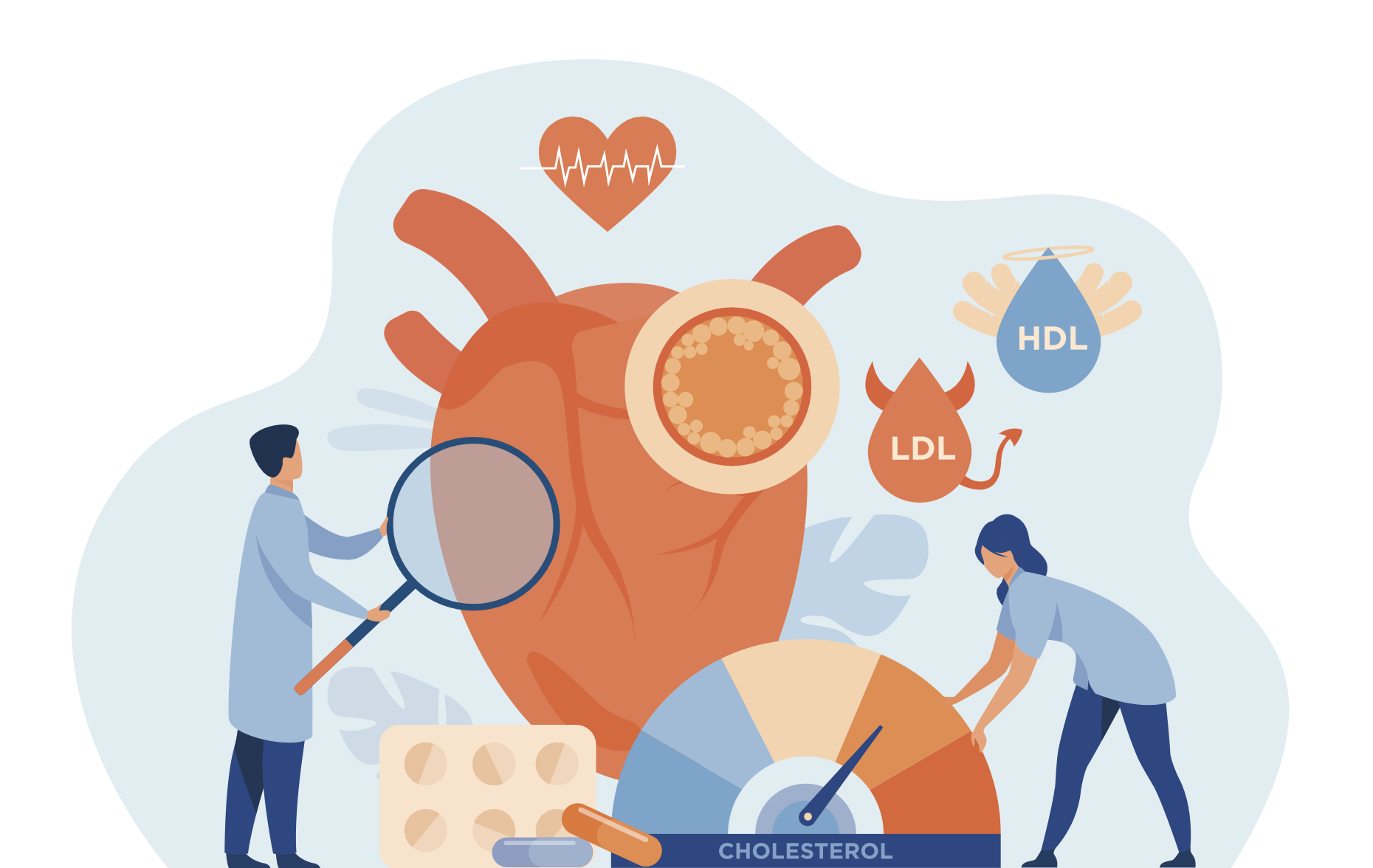Here’s what you need to know about this leading cause of heart attack and stroke
By Wendy Haaf
Janet Pritchard of Calgary had just turned 60 when her family physician told her that her blood cholesterol was high enough to warrant drug treatment. Pritchard wasn’t too concerned by the news; she’d always had high cholesterol, as did several close relatives, but her family had a stronger history of cancer than of heart disease. She deferred making a decision about starting medication, agreeing instead to return in six months for retesting.
When those results were no better, Pritchard’s doctor was more emphatic. At 6.02 mmol/L—above the 5.0 mmol/L that’s considered safe for people with no other major risk factors—Pritchard’s cholesterol level alone placed her at an increased risk for heart attack and stroke. “I was scared,” she says. So were her loved ones. When her daughter and niece learned about the doctor’s warning, Pritchard recalls, “they said, ‘Why aren’t you taking medication? We don’t want you to die.”
Cholesterol is one of the top two risk factors for heart attack worldwide, second only to smoking, according to a landmark 2004 Canadian study known as INTERHEART. In addition, “coronary artery disease is the leading cause of death in women and the second leading cause of death in men,” says Dr. Todd J. Anderson, dean of the Cumming School of Medicine and a professor in the Department of Cardiac Sciences at the University of Calgary. “Thirty per cent of people will have a cardiac event in their lifetime, and 90 percent are preventable.” Even if you survive a heart attack or stroke, your quality of life might be severely compromised.
Prior to her doctor’s warning, Pritchard knew relatively little about cholesterol, despite regular blood testing to track her levels, and like her, many otherwise healthy people probably don’t feel the need to learn about the topic in any detail until they have a good reason. However, it’s worth boning up on the basics before you run into an issue and the accompanying emotions that can make it difficult to take in new information.
So what do you need to know? Here’s a crash course in Cholesterol 101.
What is cholesterol?
Cholesterol is a waxy, fatty substance. It plays a vital role in building and repairing cells, and in creating many hormones, vitamin D, and bile, which is necessary for digestion. “The main thing to understand is that your body makes cholesterol,” says Carol Dombrow, a Toronto registered dietitian with the Heart and Stroke Foundation. The organ responsible is the liver, which produces roughly 80 per cent of the cholesterol circulating in your blood.
To travel through your bloodstream, cholesterol attaches itself to proteins, thereby forming spherical particles called lipoproteins. While there are several types, the main two of interest in heart disease are low-density lipoprotein (LDL-C) and high-density lipoprotein (HDL-C).
What’s the difference between LDL-C and HDL-C?
LDL (think L for lousy) cholesterol goes into forming plaque on the inside walls of your arteries. This increases your risk for heart attack and stroke in several ways. For example, this fatty material can rupture, allowing pieces to break off and block blood flow, causing a heart attack.
HDL, on the other hand, is the so-called healthy type of cholesterol. HDL particles are like a fleet of garbage trucks that pick up LDL and return it to the liver for disposal.
Consequently, two features of a favourable cholesterol profile are a low LDL and a high HDL (L for the number you’d like to keep low, and H for the number you’d prefer to be high.) However, both high LDL levels and low HDL levels are linked with an increased risk of cardiovascular events such as heart attack or stroke.
According to the 2014–19 Canadian Health Measures Survey, 60 per cent of Canadians aged 60 to 79 had high cholesterol. What’s even more alarming is that of these, 21 per cent had uncontrolled cholesterol despite having been diagnosed and another 23 per cent were undiagnosed.
Like high blood pressure, high levels of LDL cholesterol typically don’t cause symptoms—you need a blood test to measure them. The good news is that you now no longer need to fast for eight to 12 hours before a test, as was once the case.
Who needs to be screened for high cholesterol?
Since chances are good that you’re 55 or older if you’re reading this, you do—and on a yearly basis at that—since it’s recommended for everyone 40 and up. Testing should start even earlier for those with certain risk factors; these include Indigenous or South Asian ancestry and a history of placental syndromes during pregnancy, including pregnancy-induced hypertension, gestational diabetes, and premature delivery.
Is cholesterol testing alone enough to estimate my chances of having a cardiovascular event?
In most cases, no. “It’s important that the testing is coupled with an assessment of risk,” Anderson says.
“We tell people that cholesterol screening is a great opportunity to have a broader conversation with your health-care provider, looking at all your risk factors and your current health status,” says Opal Desmarais, a registered nurse and senior manager of Health Systems with the Heart and Stroke Foundation in Victoria.
Major risk factors over which you have no control include aging and a family history of premature cardiovascular disease (that is, one of your close relatives was diagnosed before age 55 for males and 65 for females).
The modifiable risk factors are “smoking, high blood pressure, diabetes, inactivity, and cholesterol level,” Anderson says. And a combination of just a handful of low-risk lifestyle habits—such as maintaining a healthy body weight, eating a heart-healthy diet, exercising regularly, abstaining from smoking, and getting adequate sleep—can reduce the risk for cardiovascular events by roughly 75 per cent. Consequently, these are recommended for everyone, regardless of their cholesterol levels, Anderson stresses.
In light of growing evidence that any amount of alcohol increases the risk for several cancers and other health problems, for those who do drink, experts suggest limiting consumption to “one to six drinks a week,” Anderson says. After this amount, the risk rises more sharply.
The next step after a risk assessment is for you or your health-care provider to feed certain specific risk factors into a formula or calculator. “The calculator that we use in the Canadian Cardiovascular Society guidelines is the Framingham Risk Score,” Anderson says. (You can find both a worksheet and an online calculator at ccs.ca.calculators-and-forms/.) To use these tools, you’ll need to know the following values: your blood pressure, total cholesterol, HDL, and LDL.
The results will guide whether you could benefit from cholesterol-lowering medication—typically one belonging to a family called statins. Statins are typically the first choice for two reasons: they’ve been studied extensively, and they’re all available in generic versions and so relatively inexpensive.
However, there are those who don’t need to go through this type of calculation, Anderson says: people who have already been diagnosed with heart disease, most people with diabetes, people with chronic kidney disease—regardless of their cholesterol levels—and those with an LDL-C of more than 5.0 mmol/L. “All of those people have been established to gain benefit from being on statins,” Anderson says.
Statins seem to protect against heart attack and stroke in multiple ways. First, they typically lower LDL (typically between 20 and 30 per cent, and up 50 per cent at higher doses) by curbing the liver’s ability to produce cholesterol and increasing the organ’s capacity to remove it from the blood. In addition, they also dampen the unhealthy inflammation that promotes plaque formation, and they stabilize plaque, making it less likely to burst apart.
What does the combination of cholesterol testing and risk assessment tell us?
“Basically, it puts people into three categories,” Anderson explains. “Low risk means less than a 10 per cent chance of having a cardiac event in the next decade. Most of those people don’t need drug therapy. Most high-risk individuals, who have a 20 per cent or greater risk over 10 years, should be considered for drug therapy.”
As you’ve probably guessed, if your chances of having an event over the next 10 years are between 10 and 20 per cent, you’re deemed to be at intermediate risk. “If you’re in that category and your LDL cholesterol is over 3.5 [mmol/L], then therapy is generally recommended,” Anderson says.
Your risk category also dictates your target LDL levels. If you don’t have established heart disease and start a statin, Anderson explains, “we want to see LDL cholesterol drop to less than 2.0 [mmol/L].” One recommendation that has changed in the most recent set of guidelines (2021), he continues, “is that if you do have established heart disease, the target LDL is now lower: 1.8 [mmol/L],” versus the previous 2.0 mmol/L.
“We want to be more aggressive with therapy,” Desmarais explains, “because we have a ton of great research showing the benefits of that and of preventing a secondary stroke, which we know can be so detrimental to someone’s quality of life.”
Say you’re in that middle group—your LDL is above the 3.5 mmol/L cutoff—and you want to try to bring it down before committing to taking medication. What can you do?
It depends in part on your current lifestyle. If you smoke, now’s the time to talk to your primary-care provider about strategies to help you stop. “Smoking actually reduces your level of HDL, and once you quit, you can see those levels start to rise within a few weeks,” Desmarais notes.
Exercise is another of the few things that boosts HDL. While experts recommend at least 150 minutes per week of moderate activity (walking counts), anything is better than nothing. You can also break it up into 10-minute increments, or start even smaller and gradually increase the duration.
What you eat also has an impact on the 20 per cent of blood cholesterol that your body doesn’t manufacture. However, it’s not cholesterol in food that raises your LDL, but “saturated fats,” Dombrow stresses. Sources of this include red meat and butter—both of which had featured heavily in Pritchard’s diet.
Other important themes: concentrate on the overall quality of your diet, emphasizing whole and minimally processed foods (such as vegetables, fruit, beans, legumes, whole grains, and fish); do more cooking from scratch; and cut back on restaurant meals and commercially prepared and packaged foods, which are often high in saturated fat, salt, and sugar. And that last point applies to plant-based options, too, such as vegetarian frozen dinners and veggie burgers: “they’re still highly processed foods,” Dombrow says.
That might all seem straightforward, but deciding where to start can feel confusing and overwhelming. Rather than focusing on what not to eat, Cheryl Strachan, a registered dietitian with Sweet Spot Nutrition in Calgary and the author of 30-Minute Heart Healthy Cookbook (Rockridge Press, 2019), usually recommends looking at where you can expand your food horizons.
“People don’t realize how much they can add to their diet that can actually help,” she says. “That’s more fun and easier. I often start with nuts and seeds. They have not only a cholesterol-lowering effect but also a huge effect on major cardiovascular events.”
According to the Canadian Cardiovascular Society guidelines, eating 30 grams or more of nuts each day can be expected to reduce LDL by five to seven per cent and decrease the risk of major cardiovascular events by 28 per cent.
Step two is adding more beans and legumes. “That’s a harder one for many people, but it’s so beneficial,” Strachan says. Experimenting with new recipes can help you learn how to make dishes that you enjoy. You can find all kinds of options at sweetspotnutrition.ca and heartandstroke.ca.
Strachan also avoids handing her clients a whole new meal plan or advising them to overhaul their eating habits overnight. “Because whatever they’re currently eating fits into their life, we can keep a lot of the same pattern but tweak things,” she says.
You’ve tried unsuccessfully to get my LDL into the range my doctor recommends with diet and lifestyle, but you’re leery of starting medication. What about the negative things people say about statins?
“It’s almost the same kind of thing as the misinformation about COVID vaccination,” Anderson says. “The reality is that in randomized controlled trials between statins and placebo, statins are incredibly safe,” he adds. “The side effect that’s increased is muscle aches, and those tend not to be dangerous for the majority of people.” And in fact, several trials in which participants were given a sugar pill or the real thing found that the rate of muscle aches was similar in both groups. If muscle aches do occur, they’re usually mild and can be eased with strategies such as lowering the dose or switching to a different statin. Serious muscle damage is rare—on the order of one case per 10,000 people taking statins—and often reversible.
And statins work. “Just under 19,000 deaths are avoided in Canada each year through the treatment of high cholesterol with medications—mainly statins,” Desmarais says. “The Heart and Stroke Foundation has contributed a lot to advances in the field of cholesterol control, including medications and reducing the burden of heart disease and stroke.”
Back to Janet Pritchard. After receiving that second set of concerning results, Pritchard negotiated another six-month moratorium with her doctor. A friend, a nurse who worked in cardiac rehabilitation, suggested contacting Strachan, a former colleague who had started her own practice. With Strachan’s advice and support, Pritchard gradually made changes to her daily routine. Among other things, she added more cholesterol-friendly foods to her meals, including ground flaxseed, oats, nuts, seeds, beans, and legumes.
When Pritchard’s cholesterol was first flagged as too high, she had given up exercise because a knee injury had made even walking painful. While initially afraid of triggering a heart attack when she began trying to become more active, with reassurance she kept going and has since worked up to walking six kilometres every other day, as well as going to the gym and riding her bike.
When she returned for her six-month recheck, Pritchard got some good news: “My LDL had come down 18 per cent.”
Her achievement isn’t necessarily a realistic goal for everyone; some people can do all the right things and still not reach their target—and there’s no shame in that. Our bodies are all different, and some are programmed to produce an overabundance of cholesterol. So if your primary-care provider prescribes medication, “it’s important to follow that regime,” Desmarais stresses. By reducing your risk for heart attack and stroke, and the potentially debilitating after-effects, you will “live a longer, healthier, more fulfilled life,” she says. And who doesn’t want that?






